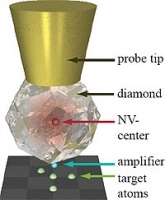Scientists have previously used microscopes that have needle-like probes down to the atomic scale to detect atoms. However, they could not identify exactly what kind of atom they were dealing with.
If a diamond is placed on the end of such a probe then it is possible to read the magnetic field signature of atoms. This can then be used to make a more accurate prediction.

Defects within a diamond hold electrons that act rather like a compass, lining up with even the very weak magnetic field emanating from the core of an atom.
One problem with this technology is that the compass has not been able to get close enough to the atom.
The team at Oxford has devised a theory that suggests that if an additional ‘compass’ is placed on the outside of the diamond, the probe can get closer to the atoms and detect their magnetic signature more accurately. The additional compass is referred to by the team as an ‘amplifier’ molecule and could be anything that has a free electron.
Dr Simon Benjamin, from Oxford University’s department of materials and the National University of Singapore, said: ‘By adding this extra electron [onto] the outside, the power of the technique has been boosted by nearly 1,000 times.’
Crucially, it is reported that this diamond compass can be ‘read’ by shining a pulse of laser light into the crystal, giving information about the location and type of atom.
The technique can be used to identify atoms in new materials or viruses.
Benjamin believes that if a device is created, which is able to identify atoms by their core signatures then it could be a revolutionary tool in chemistry, biology and medicine.





Poll: Should the UK’s railways be renationalised?
If your case is that privatising the railways accelerated the trend towards private car ownership, well, you're just plain wrong. Chart 7 <i>from your...